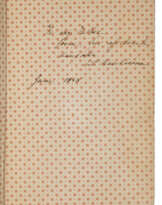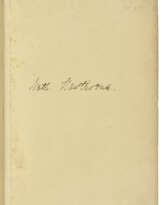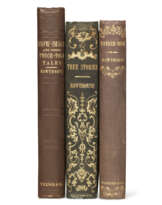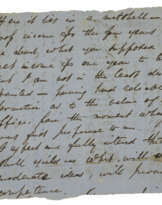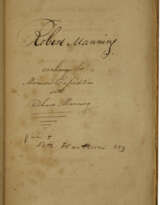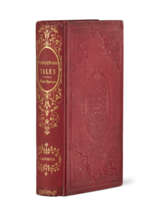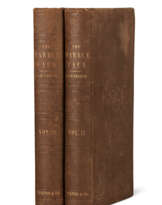ID 967637
Lot 78 | Liberty Tree, inscribed by Hawthorne
Valeur estimée
$ 10 000 – 15 000
Nathaniel Hawthorne, 1841
HAWTHORNE, Nathaniel (1804-1864). Liberty Tree: with the Last Words of Grandfather's Chair. Boston: E.P. Peabody, 1841.
A presentation copy of the first edition, the only inscribed copy to ever come up at auction. Inscribed by Hawthorne to his uncle on the title-page: "To John Dike with the author's remembrance," and additionally signed "Nath. Hawthorne" at the end of the preface.
The narrator of Hawthorne’s Liberty Tree is Grandfather, who, as in the preceding Grandfather’s Chair and Famous Old People, regales the listening children with historical tales, assisted by the prop of an old chair that, he imagines, once held a variety of great figures. Grandfather speaks proudly of the American Revolution—“The world has seen no grander movement that that of our Revolution, from first to last” (CE 6:171)—and focuses on events of the Revolution in and near Boston, including the Stamp Act, the Boston Massacre, the Boston Tea Party, and the coming of General George Washington. What is especially remarkable about Grandfather’s narration is that his great regard for the achievements of the resisting colonists is mixed with a sympathy for the misguided Tories; he teaches not only patriotism but also compassion.
This book was very much a family affair, published by Hawthorne’s future sister-in-law, Elizabeth Palmer Peabody. Hawthorne was close to the recipient of this copy, his uncle John Dike, a merchant who lived in Salem. He considered his relationship to this uncle to be, according to one Hawthorne biographer, “affectionate and stable” (Margaret B. Moore, “Hawthorne’s Uncle John Dike,” Studies in the American Renaissance 1984). And it was John Dike of Salem to whom Hawthorne later directed copies of The House of the Seven Gables (CE 16, 402, 409), A Wonder Book for Boys and Girls (CE 16:498), and The Blithedale Romance (CE 16:563). Interestingly, in 1825, Dike had offered the Hathorne family a high estimation of his nephew; twenty-one-year-old Nathaniel had objected, writing to his older sister Elizabeth, “I shall never make a distinguished figure in the world” (CE 15:194). Uncle John Dike was to be proven correct in his judgment—his nephew was to become one of the great writers of the country and the world.
When this copy sold in Gribbel's 1941 sale, the auction catalogue noted: "This is believed to be the first copy of this work bearing an autograph presentation inscription by the author, to appear at public sale in America"—it remains the first and only copy today. It is a unique presentation copy, valuably honoring both American history and the Hawthorne family.
The first edition is identified by Clark as having only one printing and having the following points: line 2 on p. 24 ending "in a Con-"; line 13, p. 30, bearing the phrase "half burned out"; line 5, p. 34, "be a governor"; and lines 8-9, p. 82, "after-wards". BAL 7592 ("printing A"); Clark A8.1 ("first edition, only printing").
32mo (121 x 77mm). Green pebbled cloth, black paper label lettered in gold (small hole at spine, label rubbed, front hinge cracked but holding); modern chemise and pull-off case. Provenance: John Gribbel (bookplate, his sale, Parke-Bernet, 22-24 January 1941, lot 299) – Walter Chrysler (bookplate, Parke-Bernet, 7 December 1954, lot 154) – Christie's New York, 18 November 1988, lot 166.
| Artiste: | Nathaniel Hawthorne (1804 - 1864) |
|---|---|
| Catégorie maison de vente aux enchères: | Livres imprimés |
| Artiste: | Nathaniel Hawthorne (1804 - 1864) |
|---|---|
| Catégorie maison de vente aux enchères: | Livres imprimés |
| Adresse de l'enchère |
CHRISTIE'S 20 Rockefeller Plaza 10020 New York Etats-Unis | ||||||||||||||
|---|---|---|---|---|---|---|---|---|---|---|---|---|---|---|---|
| Aperçu |
| ||||||||||||||
| Téléphone | +1 212 636 2000 | ||||||||||||||
| Fax | +1 212 636 4930 | ||||||||||||||
| Conditions d'utilisation | Conditions d'utilisation | ||||||||||||||
| transport |
Service postal Service de messagerie ramassage par vous-même | ||||||||||||||
| Modes de paiement |
Virement bancaire | ||||||||||||||
| Heures d'ouverture | Heures d'ouverture
|



